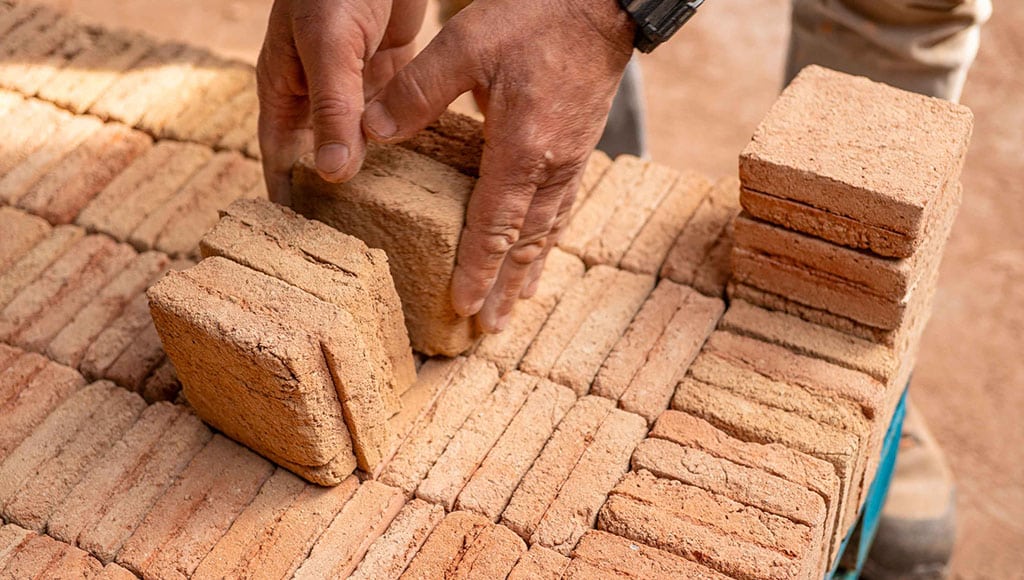Walk like an Egyptian! Sometimes, the best things in life are right under your nose, or perhaps your feet. If you live in the Algarve, it’s likely that you walk on them every day.
They have been around for 5,000 years, since the beginnings of civilization. They were invented by the ancient Egyptians, Chinese, and Persians. Then they were passed down by the Greeks, Romans, and Moors. Today, they are being made the SAME EXACT WAY in a small town in the Algarve, Santa Catarina da Fonte do Bispo.
I am talking about the lovely, earthy, and simply elegant Santa Catarina clay tiles.
My wife and I are among those who tread on them daily at home, and we wanted to find out for ourselves how they are made. We were thrilled with what we found. Yes, I am happy to report that today, in the Algarve, there are skilled tilemakers producing these ancient beauties, completely by hand, using the same process as began 5,000 years ago.
On the day of our visit, after enjoying “uma bica” and the special local pastry in the nearby village of Santa Catarina da Fonte do Bispo, we meet Elisabete Rocha. She has inherited the 60-year-old tile company named after her father, Alberto Rocha. After a career in civil engineering, Elisabete now manages the company.
Alberto Rocha is located on rolling land, dotted with olive trees. Here, the rich red Santa Catarina clay is plentiful. After looking down into a clay pit the size of a house, we enter a covered building, perhaps as big as a football pitch, with a very flat dirt floor.

On the floor are thousands of various tiles, neatly placed in groups, according to size, color, and style. There are narrow footpaths between each group. The tiles on the floor are placed there for drying and, after five days or so, depending on the outdoor temperature and humidity, they are ready for the baking process.
There is a man wearing sandals, walking on top of the tiles, and whacking them down with a flat wooden board. This is done to keep the tiles flat during drying. As we walk around, there is a constant “whack, whack, whack” in the background.
In the middle of all this are two men, standing at a table, making tiles by hand, one at a time. When I say by hand, I mean BY HAND. They have no tools, not even gloves.
One man rhythmically scoops a handful of clay from a pile to his left, kneads it for a few seconds, squishes it into a frame, and runs a wet piece of wood over it.
The second man puts a thin plate under the tile, and carefully places it nearby on the floor to dry. Repeat. That’s it. They make it look easy, but like most things in life, I’m sure it takes years of practice to do it so well.
An average of 1,300 tiles are produced each day. Some of the tiles have a striped design. For this, the second man dips his hand in a bucket of watery, golden-colored clay. Then he makes the stripes by dragging his fingers across the wet tile. Done.
Now it is time for the morning break. Six or seven tilemakers sit on an old bench or a box in the corner. They chat and munch on bread. The atmosphere is calm and peaceful. There is no evidence of a radio or a coffee machine.
When the tiles are dry, they are ready for baking. Two men, kneeling on cushions, painstakingly place them in room-sized ovens. The tiles are carefully arranged in pairs, back to back, on end, with an intricately overlapping criss-cross pattern. The pattern allows the high heat to flow evenly throughout the thousands of tiles.
The ovens are fired on weekends, and the firing lasts about 36 hours. The fuel is local firewood mixed with remnants of the region’s olive oil production: dried pits, stems, and olive fiber. No electricity or fossil fuels are used. The oven temperature will reach 1000°C.
In a world where everything is computerized, automated, and mechanized, isn’t it refreshing to find a family business that uses ingredients from the land nearby, and embraces the old way of doing things? In my mind, it is an example of Portugal at its best.
It’s also fascinating that these tiles are quite fashionable in today’s interior design world. Artistic and worldly people see the visual and intrinsic beauty in them. You can see stylish homes, depicted in sophisticated magazines, with Santa Catarina tile underneath sleek modern furniture.
Of course, it is also lovely and pleasing in a rustic or traditional setting.
So, maybe it’ll be just the thing for you to “Walk like an Egyptian” (from the Bangles #1 hit song of 1987).
By ERIC ROTH
|| features@portugalresident.com
Eric Roth is a lifelong photojournalist who has recently emigrated from Boston, USA to the Algarve. He loves nature and wildlife. 926 742 687 | ericrothphoto@gmail.com




















